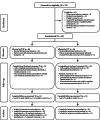Treating Child Disruptive Behavior in High-Risk Families: A Comparative Effectiveness Trial from a Community-Based Implementation
- PMID: 27110086
- PMCID: PMC4824803
- DOI: 10.1007/s10826-015-0322-4
Treating Child Disruptive Behavior in High-Risk Families: A Comparative Effectiveness Trial from a Community-Based Implementation
Abstract
Parent management training programs have proven the most effective way to treat child behavior problems. This study reports on an effectiveness trial of a community-based implementation of Parent-Child Interaction Therapy (PCIT) in comparison with the Dutch-developed Family Creative Therapy (FCT). Forty-five children (58 % boys) aged between 32 and 102 months (M = 67.7, SD = 15.9) were referred for treatment, and they and their parent(s) were randomly assigned to PCIT or FCT. Treatment effectiveness was measured primarily by the degree of improvement on child behavior problems, using the Eyberg Child Behavior Inventory. Secondary outcomes included parent and teacher report data and independent observations of parenting skills and child behavior. During the trial, randomization was violated by treatment crossovers (from FCT to PCIT). Intention-to-treat analyzes revealed no significant differences in the primary outcome at 6-month follow-up, but interpretation was hampered by the crossovers. Subsequent treatment-received analyzes revealed significant interaction effects between time and treatment condition, with greater improvements in child behavior and parenting skills for PCIT families compared to FCT families. Analyzes on families that fully completed the PCIT protocol also showed higher treatment maintenance at follow-up. The treatment-received analyzes indicated promising results for the effectiveness of PCIT in treating young children's disruptive behavior problems in a high-risk population. However, caution in generalizing the conclusions is needed in view of the design difficulties in this study. Suggestions are made for enhancing treatment delivery in daily practice, and clinical implications are noted.
Keywords: Community mental health; Disruptive behavior; Parent management training program; Parent–child interaction.
Figures
References
-
- Abidin RR. Parenting stress index: Professional manual. 3. Odessa, FL: Psychological Assessment Resources; 1995.
-
- Achenbach TM, Rescorla LA. Manual for the ASEBA preschool forms and profiles. Burlingtion, VT: University of Vermont; 2000.
-
- Achenbach TM, Rescorla LA. Manual for the ASEBA school age forms and profiles. Burlingtion, VT: University of Vermont; 2001.
LinkOut - more resources
Full Text Sources
Other Literature Sources

